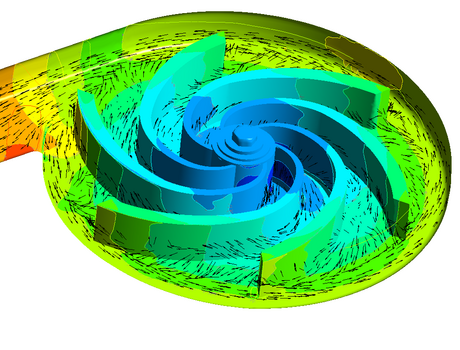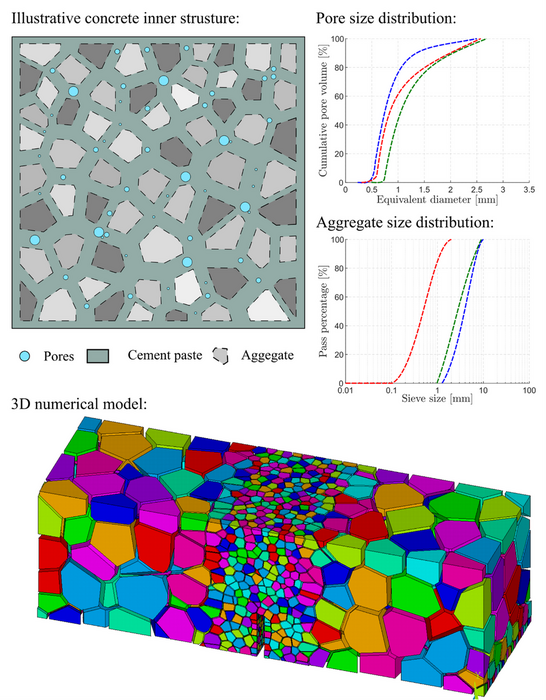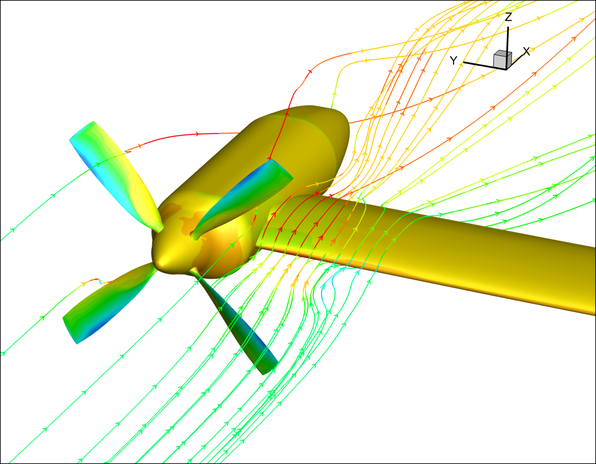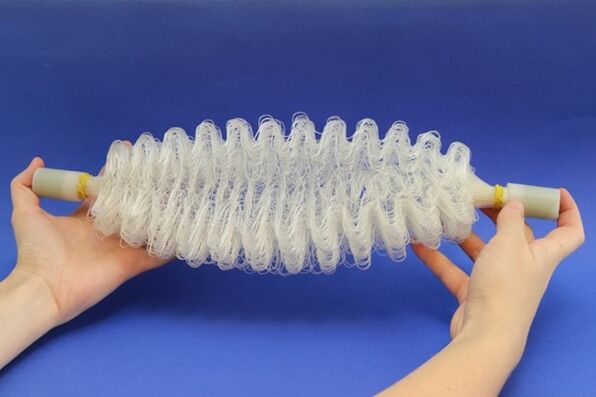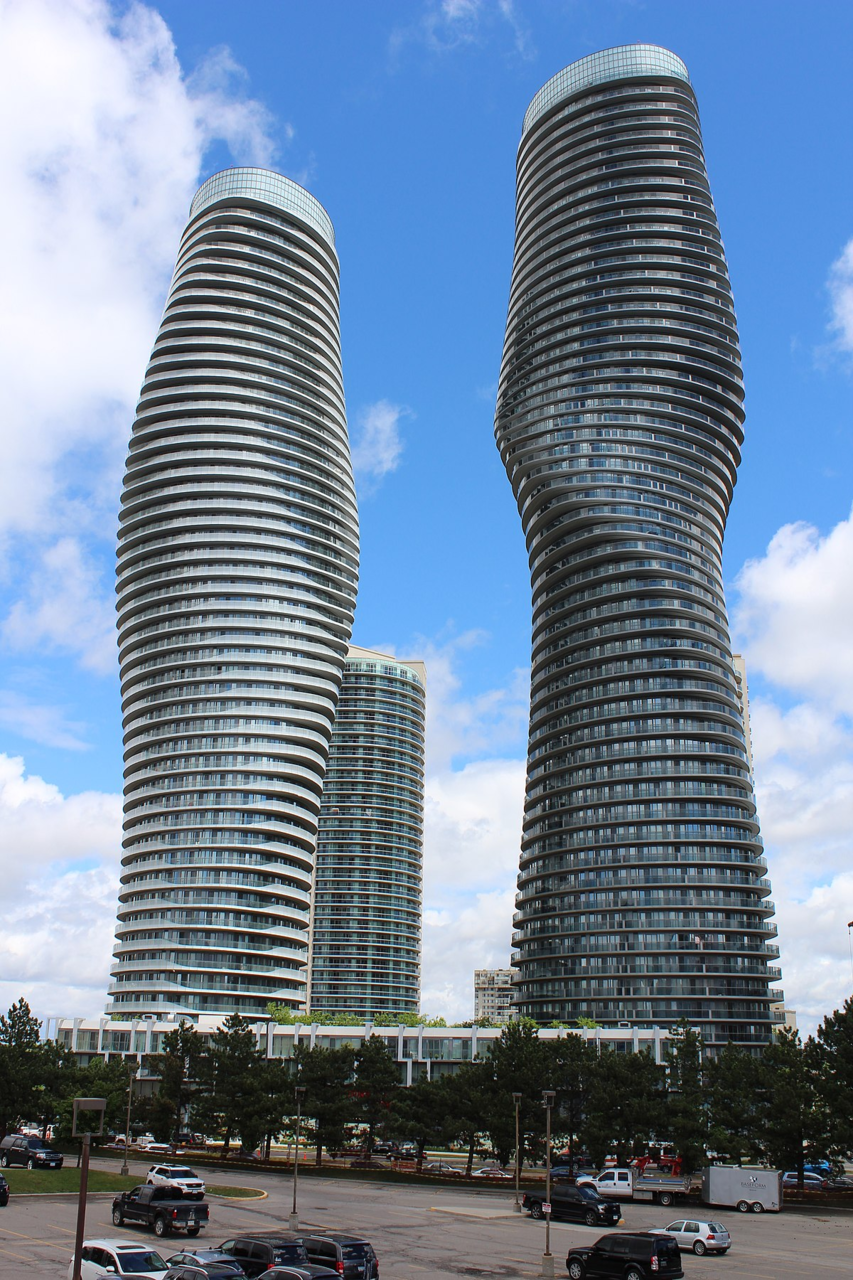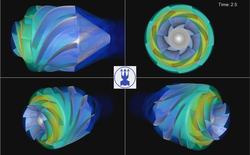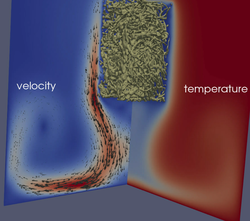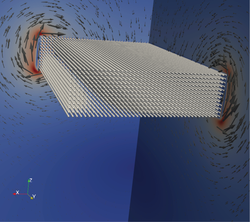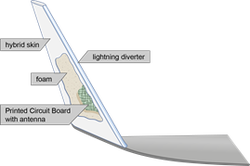Machine learning-based surrogate modeling for conjugate heat transfer enhancement with complex surface geometry: CFD simulation
Call: 34th Open Access Grant Competition; OPEN-34-86
Researcher: Jan Boháček
Institution: Brno University of Technology
Field: Engineering
Jan Boháček from Brno University of Technology will utilise the supercomputers Barbora and Karolina to develop a computationally efficient and accurate framework for modelling conjugate heat transfer in complex surface geometries. These calculations are typically performed using CFD simulations, which, at high accuracy, demand substantial computational resources.
The aim of the project is to employ machine learning methods to create so-called surrogate models that can replace parts of these resource-intensive simulations. This approach will reduce computational costs while maintaining result reliability, enabling more efficient optimisation of heat transfer.
The research is supported by the Czech Science Foundation project GA ČR 25-16935S.
Optimisation of design and production processes of vertical pumps using modern technologies
Call: 31st Open Access Grant Competition; OPEN-31-33
Researcher: Tomáš Blejchař
Institution: IT4Innovations
Field: Engineering
The project of Tomáš Blejchař from IT4Innovations focuses on improving the design of vertical pumps using artificial intelligence and machine learning. Pumps are among the most used machines in industry and everyday life. Their efficient design is critical to reducing energy consumption, which is especially important for pumps running continuously, such as water and wastewater treatment plants, heating and air conditioning systems, etc.
Pump design is a complex process influenced by many input parameters and involves manual calculations followed by numerical simulations. This project aims to use neural networks and artificial intelligence to simplify pump design, specifically to automatically correct the initial rough calculations, allowing the optimal pump design to be found in a single step. This will save not only the energy and computational resources required for iterative numerical simulations but also the time required to find the optimal pump design.
This research is closely related to the project funded by the Trend programme of the Technology Agency of the Czech Republic (FW10010202).
Concrete Fracture: A meso-level approach
Call: 29th Open Access Grant Competition; OPEN-29-13
Researcher: Petr Miarka
Institution: Institute of Physics of Materials of the Czech Academy of Sciences
Field: Engineering
Ilustrace heterogenní struktury betonu se zohledněním různé velikosti kameniva a pórů včetně 3D numerického modelu.
The fracture of concrete is a complex mechanism influenced by its highly heterogeneous inner structure: matrix/cement paste, aggregates, and pores. Aggregates and cement paste do not represent an ideal connection, which is often considered the weakest link within the material. This often results in certain practical limitations. In concrete, which uses Portland cement as the binder, the behaviour of this material interface is relatively well investigated. Recently, material science has set its focus on the design of non-cementitious binders, which have a significantly lower carbon footprint compared to cement. However, the damage mechanisms of these modern materials can differ significantly from conventional concrete.
The computational resources at the Barbora supercomputer at IT4Innovations are used for creating complex numerical models that, in detail, consider this natural material's heterogenous inner structure. The obtained results then allow for the understanding of the onset of damage at the paste/aggregate interface and explain the role of pores during the damage evolution due to static or cyclic load. Understanding the damage evolution can contribute to faster applications of these alternative binders in structural engineering.
PROP
Call: 25th Open Access Grant Competition; OPEN-25-36
Researcher: Aleš Prachař
Institution: The Czech Aerospace Research Centre
Field: Engineering
The project PROP is focused on the studying of the effect of the propeller slipstream on the performance of the wing and its parts by means of the high-fidelity CFD simulations to design the high-performance wing. With the need to fulfil the requirements of the reduction of the fuel consumption and emissions and increase of the efficiency, the utilization of propeller-driven aircrafts with wing-mounted engines and laminar wing technology becomes increasingly attractive. The knowledge about the propeller-wing interference needs to be investigated in more detail. This includes understanding of unsteady slipstream phenomena with transient effects on the wing. Parameters like the positions of the propeller with respect to the wing will be investigated too. For low-speed high lift conditions, the increased efficiency of high lift devices due to the impact of the propeller slipstream will have to be considered during the design phase of the wing segments affected by the propeller.
Fluid Flow Simulations in a Complex Computational Domains
Call: 23rd Open Access Grant Competition; OPEN-23-35
Researcher: Kryštof Mráz
Institution: Brno University of Technology
Field: Engineering
Porous structures and products with a complex inner geometry are still considered as a considerable challenge for standard computational modeling. Heat exchangers made of polymeric hollow fibers can be considered as a porous structure as well, because they normally consist of hundreds or thousands of fibers with outer diameter approx. 1 mm. However, the comprehensive numeric simulation of the whole heat exchanger is highly desirable, because it would fill the gap between rather simplifying analytical models and empirical experiments. The aim of this project is to utilize the so-called Lattice Boltzmann method for numerical simulation of flow and heat transfer through hollow fiber heat exchangers. This method is unique in the fact that it is based on statistical physics of molecular motion in gases. An important aspect of this method is also its suitability for parallel high-performance computing.
VALIDATION OF EXASCALE DEMONSTRATORS
Call: 21st Open Access Grant Competition
Researcher: Dr Tomáš Karásek
Institution: IT4Innovations, VŠB-TUO
Field: Engineering
The project is part of a three-year ExaQUte project, which develops new methods for solving complex engineering problems using computational simulations on exascale systems. The aim is to construct a framework to enable Uncertainty Quantification (UQ) and Optimization Under Uncertainties (OUU) in complex engineering problems.
Solution of UQ and OUU problems rely on the estimation of unknown quantities by performing many independent simulations on different scenarios. This poses an important challenge as many computational resources are needed to perform these analyses. Nonetheless, the independent sampling allows for high parallelization of the analyses in order to exploit HPC systems.
The methods and tools developed in ExaQUte will be applicable to many fields of science and technology. The application chosen as a demonstrator focuses on wind engineering, a field of notable industrial interest for which currently no reliable solution exists. This will include the quantification of uncertainties in the response of civil engineering structures to the wind action, and the shape optimization taking into account uncertainties related to wind loading, structural shape and material behaviour. Wind also plays an important role in the assessment of citizens comfort, particularly when large constructions are to be made (e.g. re-modelling of city areas, construction of high-rise buildings), becoming this an application of public interest.
INVESTIGATION OF FLUIDIZATION REGIMES IN WURSTER FLUID BED COATER
Call: 15th Open Access Grant Competition
Researcher: Jiří Kolář
Institution: University of Chemistry and Technology
Field: Engineering
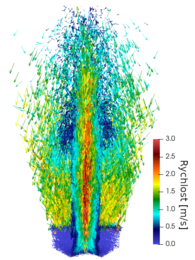
The Wurster fluid bed device is widely used in pharmacy for the coating of small pellets. Coating is used to apply layers onto the pellets with various functions. Some layers can consist of active pharmaceutical ingredients (API), and others can be used to protect the API from decomposing, or prolong the drug effect. However, it is difficult to set the process operating parameters optimally to obtain product of a pharmaceutical quality. Being awarded almost 3 million core hours, the project of Jiří Kolář from the University of Chemistry and Technology in Prague is focused on analysis of dependency of fluidization regimes on operating parameters setting in a Wurster fluid bed coater using computationally intensive simulations. Jiří Kolář will then seek to find an optimal simplification of this model, which could have the capacity to speed up the drug design and reduce its costs.
AN OPEN-SOURCE BASED FRAMEWORK FOR CFD-BASED OPTIMIZATION OF ROTARY MACHINES
Call: 14th Open Access Grant Competition
Researcher: Tomáš Krátký
Institution: Palacký University Olomouc
Field: Engineering
Tomáš Krátký from Palacký University Olomouc was awarded half a million core hours for the development of a fully automated model for CFD-based rotary machine simulations. Solely based on open source software (OpenFOAM, Python), this brand new model will allow designers to optimize the shapes of rotary machines to achieve their best possible hydraulic performance. They will thus achieve better designs of rotary machines in a shorter time. The new computational approach will be used in pump design, which is expected to outmatch the currently used ones by its performance parameters. Research and development in the field of numerical simulation for shape optimization plays a key role for pump and turbine manufacturers. Drawing the benefits of a faster and cheaper computational approach for hydraulic designs, companies may thus optimize and tailor their products for their customers.
RESEARCH CENTRE FOR LOW-CARBON ENERGY TECHNOLOGIES
Call: 13th Open Access Grant Competition
Researcher: Dr Jan Boháček
Institution: Brno University of Technology
Field: Engineering
The supercomputing project of Jan Boháček from Brno University of Technology (BUT), who is involved in the fiveyear long project Research centre for low-carbon energy technologies (CVNET, CZ.02.1.01/0.0/0.0/16_019/0000753) supported by the Research, Development and Education Operational Programme, was awarded almost 1 million core hours. The Heat Transfer and Fluid Flow Laboratory at BUT has been involved in the development of modern polymeric heat exchangers with hollow fibres for 10 years so far. The advantage of using polymeric hollow fibres in heat exchangers is their flexibility, low costs, and chemical resistance. Polymeric heat exchangers are ideal, for example, for heating, air-conditioning, and low-potential residual heat applications. The allocated computational resources will be used by the group of BUT researchers for development of polymeric heat exchangers, in particular for detailed heat transfer simulations. They will analyse different factors, which affect heat transfer in polymeric hollow microfibers (diameter, lengths, and fibre spacing).
INTA
Call: 11th Open Access Grant Competition
Researcher: Dr Petr Vrchota
Institution: The Czech Aerospace Research Centre
Field: Engineering
Design of new regional aircraft and airlines is mainly influenced by economic and environmental factors. Individual parts of airplanes are optimized, for example, with respect to aerodynamic efficiency, fuel consumption, and emissions. Another option for reducing the aerodynamic drag and saving fuel are optimized integrated communication antennas. The antennas usually protrude and contribute to the total drag of the airplane. The IntA project of Dr. Petr Vrchota from the Czech Aerospace Research Centre has been awarded 200,000 core hours. This project focuses on designing a new winglet with an integrated antenna to improve the flight performance and aerodynamic efficiency of the entire aeroplane and reduce fuel consumption as well as negative environmental impacts. The objective of the research project is to reduce the aerodynamic drag of the aeroplane by up to 2 % using the integrated antenna.

